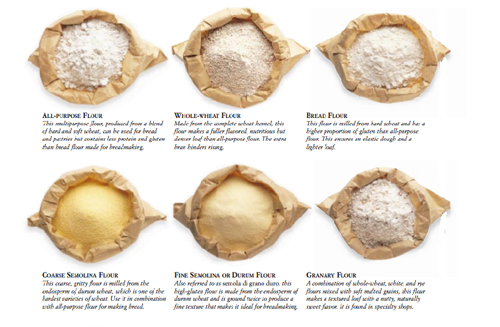Different types of flour and their storage method
Classification of flour

-
Whole wheat flour
Whole wheat flour is a whole wheat that is milled without the need to remove the bran process. The whole wheat flour contains bran and germ. The bran in wheat contains very high nutritional value of cellulose.
-
Bread Flour
Bread flour is not equal to high-gluten flour. The so-called bread-specific powder is added to flour to improve the bread making performance of flour. Malt, vitamins, and gluten increase the amount of protein so that bread can be made more easily. As a result, flour with a protein content of 14-15% has emerged, so that larger bread can be made.
In addition, there is a so-called mixed powder which can be simply made into a bread embryo by mixing it with water and two or three materials.
-
Cake flour
Cake flour, also known as cake powder. In fact, low-gluten flour is not equal to cake flour, because in foreign countries, in some areas where the flour is classified finely, the low-gluten flour is also divided into two grades. One is Cake Flour, which means that the low-gluten flour is treated with chlorine gas, which lowers the acid value of the original low-gluten flour, which is beneficial to the organization of the cake. The other is Pastry Flour. The gluten of the powder is slightly higher than the cake powder, but it is also a low-gluten flour.
Of course, in China, the classification of commercially available household flour is not detailed. You can use low-gluten flour as a cake powder. It is no problem to make cakes and cakes. If you can't buy low-gluten flour, you can also use medium-gluten flour and 20% corn starch to replace it, that is, medium-gluten flour: corn starch = 4:1, corn starch can reduce the flouriness of flour.
-
Stone milled flour
Stone mill flour is a flour that has been processed without any additives by a conventional stone mill (stone mill speed of 20 rpm). Low-speed grinding and low-temperature processing will not damage the nutrients in wheat. Therefore, stone flour retains the maximum protein, gluten, carotene, carbohydrate, calcium, phosphorus, iron, vitamin B1.B2 in wheat. The nutrients, especially the carotene and vitamin E in the stone flour are 18 times that of other flours. Its low-speed grinding features maintain the molecular structure of the flour without any additives. When cooking noodles, the surface of the stone flour flour is light yellow, while other flour-containing soups with additives are white in color. Therefore, the stone mill flour retains the original flavor of wheat, and the various pastas made with stone mill flour are soft, wheaty, and have higher nutritional value, and are truly natural green healthy foods.
The traditional stone mill is made up of two round stones that have been hammered and drilled by axe. Both of them are made of large stones with a certain thickness and are carved into a flat cylindrical shape. Out of a twill, called grinding teeth. Stone grinding and grinding is a professional and complex technology. Its reasonable, natural and scientific design features must be manually modulated. Its angle, size and clearance are irreplaceable by some modern tools.
The primary color flour with a slightly yellowish color has a higher nutritional value. The yellow color of the primary color flour is because it retains a large amount of B vitamins, which is of great benefit to the human nervous system and skin tissue.
Characteristics of stone mill flour
1. low-speed low-temperature grinding of stone mill will not damage the nutrients in wheat, and retain the most nutrients such as protein, carotene, carbohydrate, calcium, phosphorus, iron and vitamins in wheat, especially carotene. 18 times more than other vitamins and vitamins.
2. Its low-speed grinding features maintain the molecular structure of the flour without any additives.
3. When cooking noodles, the flour noodle soup is light yellow, while other flour-containing soups containing additives are white in color.
Storage method

1. Well ventilated flour has a respiration effect, so the air must be circulated so that the flour has air for use.
2. Humidity dry flour will change its water content according to the temperature and humidity of the environment, the greater the humidity, the increased moisture content of the flour, easy to agglomerate. The lower the humidity, the lower the moisture content of the flour. The ideal humidity is between 60% and 70%.
3. The temperature of the appropriate temperature storage will affect the ripening time of the flour, the higher the temperature, the faster the ripening. But the temperature also shortens the shelf life of the flour. The ideal temperature for flour storage is 18 ° C - 24 ° C.
4. Clean environment clean environment can reduce the breeding of pests, microbial reproduction, thereby reducing the chance of contamination of flour.
5. No odor flour is a material that absorbs and stores odor in the air, so there is no odor in the surrounding environment where the flour is stored.
6. It is necessary to leave the wall from the ground in order to have good ventilation, reduce dampness, reduce the pollution of pests and the provisions of the law. The weight plate should be made of plastic products. If wood products are used, be careful of wood thorns to make pollution.
7. The first-in-first-out guarantees the stability of the flour and reduces the artificial over-expansion of the flour.
8. Regular cleaning to reduce the breeding of pests, thereby reducing the chance of flour contamination, packaging damage




